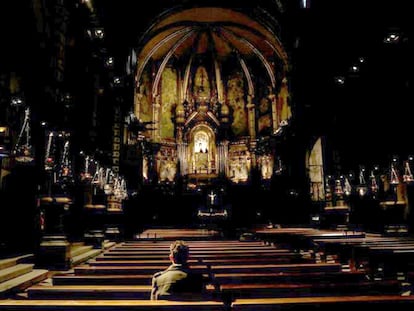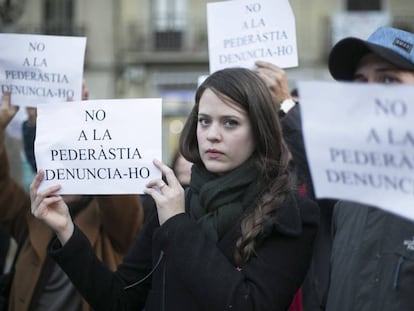Investigation estimates that there are more than 440,000 living victims of sexual abuse that took place within the Spanish Catholic Church
The historic report released by Spain’s ombudsman details the abuses committed by clergy members, calling out the religious institution in harsh terms. According to the figures released, Spain is the country with the highest official projection of victims
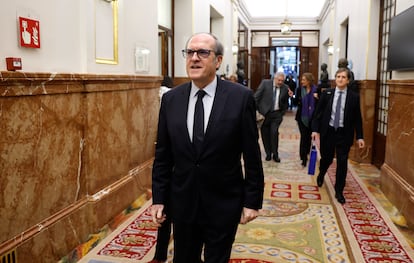
EL PAÍS launched an investigation into pedophilia within the Spanish Catholic Church in 2018 and has an updated database with all known cases. If you know of any case that has not been reported, you can write to us at: abusos@elpais.es. If it’s a case in Latin America, the email address is: abusamerica@elpais.es
Spain has become a global exception among majority-Catholic countries. It went from having no officially recognized cases of pedophilia within the Catholic Church to being the country with the highest number of victims in the world. It is estimated that 1.13% of the current adult population has suffered abuse in the religious sphere. This is according to a large-scale survey, the first of its kind in the country, carried out by Ombudsman Ángel Gabilondo.
The ombudsman avoided making the calculation in round numbers during his appearance in the Congress of Deputies on Friday, October 27. His final report also doesn’t offer such figures. However, according to calculations by EL PAÍS, that 1.13% of the 38.9 million people registered in Spain in 2022 aged between 18 and 90 (the age range covered by the survey) corresponds to some 440,000 people. More specifically, of that 1.13%, 0.6% — some 233,000 people — claim to have suffered abuse from priests or lay people. More than 8,000 people were interviewed for the survey.
The demographic study is one of the pillars of the investigation that Gabilondo presented on Friday morning, 18 months after Congress commissioned it. He presented the report as an attempt to shed light on this hidden problem. He also criticized “the silence of those who could have done more to prevent” pedophilia.
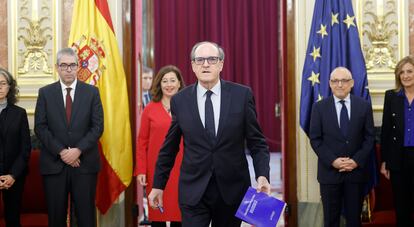
These overwhelming figures — which exceed the 330,000 victims estimated by France in 2021 — represent a historic turnaround after decades of silencing the abuses. Since the sexual abuse scandal broke out in other countries starting in 2002, the Catholic Church of Spain has engaged in years of denial and cover-ups. Just two years ago, the spokesman for Spain’s bishops, Luis Argüello, stated that he knew of “zero or very few complaints” of sexual abuse by church officials.
The investigation that EL PAÍS has undertaken since 2018 has had a major impact, bringing the voices of hundreds of victims to the surface. By 2022, these efforts forced Congress to seek the truth about what happened. As of Friday, the first step has been taken.
This newspaper took part in the work that was organized by the ombudsman’s commission, offering all available data. Gabilondo highlighted this collaboration on Friday, noting that EL PAÍS had been one of the sources of information for the study and the subsequent report. The Church, meanwhile, after initially agreeing to reveal its own data, offered incomplete and uncoordinated support. Dioceses and orders admitted to 1,104 cases of abuse and 1,430 victims (921 from the orders and 509 from the dioceses). These figures were the highest ones publicly available, until now. In April of 2021 — the first time the Spanish Catholic Church officially admitted to the existence of sexual abuse victims — only 220 cases were acknowledged.
The estimated 1.13% of adult Spaniards who have suffered abuse in the Catholic religious sphere — according to the survey carried out by the consulting firm GAD3 on behalf of the ombudsman — are divided into two groups. Of the cases of sexual assault, 0.6% were at the hands of priests or religious figures, while the rest were committed by lay people who worked within Catholic institutions. The study indicates that this 0.6% is “a figure similar to that found in studies carried out in other countries.”
Findings from the study are framed in a context of even more serious abuses. The survey reveals that 11.7% of the people interviewed have been victims of sexual abuse in childhood or adolescence, mainly in the family environment. In total, the prevalence is higher among women — at 17% — while it stands at 6% among men. In the religious sphere, however, this data is reversed: it is men who have suffered the most abuse. They represent 53.8% of people abused in the Spanish religious sphere, as well as 64.6% of those who were sexually assaulted by a priest or religious figure.
The exhaustive 779-page-long report is titled “Sexual Abuse in the Catholic Church and the Role of the Public Authorities.” A necessary response to widespread crimes, it’s a very meticulous document that firmly reproaches the Catholic Church of Spain for failing to adequately collaborate in the investigation.
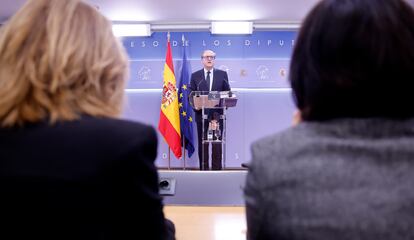
“The response of the Catholic Church — at least, at the official level — has long been characterized by denial or minimization of the problem,” the report notes. The response of the Spanish Episcopal Conference to the inquiry commission’s request for information “still reflects an attitude characterized by caution and reluctance. Beyond a declared willingness to collaborate, the data [offered by the Church] has been presented in a way that tends to minimize the phenomenon and relegate it to a marginal aspect within the institution, emphasizing the social dimension of the problem and avoiding to address the internal factors that favor the dynamics of abuse and cover-up.”
The document alleges that the Church’s “defensive argument that the investigation should be extended to sexual abuse in other areas [is an attempt] to dismiss or minimize the social relevance of the Church and its power in Spain during much of the 20th century. Furthermore, [such a response] gives the impression that the Church isn’t especially interested in learning about the crimes.” Along these lines, the ombudsman notes that “certain attitudes have been detected in some episcopates… indicating a reluctance to recognize and investigate cases of abuse.”
As an example, he cites the lack of attention to some complaints when no information has been found in the files, “presuming in some way that the complainants — who are often adults over the age of 60 — have a spurious interest. [There is little] will to investigate the cases.” Regarding the diocesan archives, the information “has turned out to be… almost non-existent,” although many dioceses have only consulted them, not completely reviewed them.

One of the most relevant points of the report is that it doesn’t spare criticism of the institutions, which, “for a long time, have remained inactive in the face of the reality of sexual abuse and haven’t made the necessary efforts to protect minors” in educational centers. For this reason, it considers that the state as a supervisor also has a responsibility to bear for what has happened. The ombudsman proposes “the creation of a special temporary body, whose purpose is to compensate the victims in the cases in which — due to the statute of limitations of the crime or other causes — a criminal process couldn’t be carried out.” To this end, the report recommends “the creation of a state fund for the payment of compensation,” in collaboration with the Church.
“Public authorities have the responsibility of guaranteeing that the victims of these crimes can see that their right to justice [is fulfilled].” This should be done “through some type of public declaration in which — based on a principle of evidence presented before a special body made up of independent experts — it is stated that [a crime] has taken place, its unjust nature is expressed and those who have suffered its consequences are recognized as victims. Additionally, reparations must be agreed upon.”
Among the recommendations, however, the report doesn’t include the application of one of the main demands of the victims’ associations: the imprescriptibility of these crimes (or the voiding of the statute of limitations). The report indicates that the handling of these offences wouldn’t have a retroactive effect. Instead, it focuses on proposals for reparation and recognition of the harm done to victims. It also proposes holding a public ceremony to recognize the victims.
As a background to the problem, the report points out that “there is evidence that clericalism — strongly rooted within the Catholic Church — with the sacralization of the figure of the priest as God’s representative on Earth, the loneliness of many clerics and the associated problems of sexuality” are factors that could have led to abuse. Regarding specific risk factors, the report indicates that academic research points “to mandatory celibacy, the practice of administering penance and a certain vision of sexuality.”
“For a long time, the Catholic Church has perceived sexual abuse more as a sin of the abuser than as harm caused to the abused person. This conception has been overcome, although only recently,” the study points out.
8,013 interviews
The survey included in the report is based on 8,013 interviews, of which 4,802 were conducted by telephone and 3,211 online. A total of 113,126 calls were made, in which 23,991 people were contacted. Among those surveyed who reported abuse, the majority said that it occurred in the family environment (34.1%), as all studies tend to indicate. This was followed by public spaces (17.7%), the secular educational sphere (9.6%), the non-familial social sphere (9.5%), the workplace (7.5%), online (7.3%), religious educational institutions (5.9%), the religious sphere (4.6%), leisure spaces (4%), sporting events and activities (3%) and healthcare facilities (2.6%). That is to say, the study notes, “that practically 6.6% of all sexual abuses [in Spain] have occurred in religious establishments.”
Overall, 6.1% of people who had been sexually abused responded that the perpetrator was a Catholic priest or religious figure. And, furthermore, 29.3% of the victims indicated that they directly knew other people who had been abused by the same person. More than half of those who had been victims within the religious sphere — 51.9% to be exact — stated that they were aware of other cases of abuse committed by the same perpetrator.
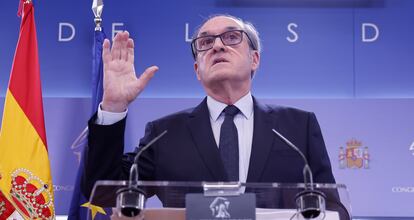
The report explains that the body in charge of the investigation commissioned the survey because “without this data, it is impossible to be able to raise a voice — with a solid empirical basis — in the debate about the scope of the problem in Spain and whether the prevalence is comparable or not to what has been detected in other European countries.” The questionnaire consisted of 34 queries in total: 10 of them were addressed to all the people surveyed, while the remaining 24 were reserved for those who reported experiences of sexual abuse when they were minors.
The study analyzed the widespread problem of pedophilia within the Church by listening to victims: 487 people approached the ombudsman to provide their testimony. The majority — 334 — gave their testimony in-person. This work has served to comprehend the issue in depth. However, the objective wasn’t to quantify victims one by one, a task that seemed impossible. Rather, the commission compiled the existing numbers through two means: the cases collected by the Catholic Church itself — from dioceses, orders and the Episcopal Conference, which “didn’t always coincide with each other” — and the investigation carried out by EL PAÍS. The report is careful to emphasize that the data “doesn’t represent more than a small part of a much more widespread reality.”
Until this report began to be put together, the Catholic Church of Spain had always refused to reveal what it knew about past cases of abuse. Still, the information provided has been limited. The Ombudsman has pulled data from three places: the 70 Spanish dioceses, the 410 religious orders and the global numbers reported by the Spanish Episcopal Conference. The latter organization responded with already-known data: the offices they created in 2019 received — between then and December 31, 2022 — testimonies from 927 victims.
The dioceses, meanwhile, admitted to 318 cases. The orders reported 786. In total, 1,104 cases of sexual assault within the Church. Yet, this number doesn’t coincide with the overall number from the Episcopal Conference — there’s also no way of knowing if the cases are duplicates.
This data exceeds the cases currently registered by the EL PAÍS database (1,036). Another issue is that the Church’s responses have only provided anonymous data, which makes it impossible to cross-reference them with what has been obtained through EL PAÍS and the testimonies collected by the ombudsman. It’s difficult to come to a single conclusive figure.
While highlighting that the data is incomplete, the report is critical of the bishops who, in some cases, haven’t even responded to the requests made by the ombudsman’s commission: “There are bishops who seem to have decided to avoid the issue, who want to turn the page. They are more concerned about the consequences for the institution [than the effect that the abuses have had on the victims]. This leads them to recognize a minimum of cases… or even none, despite the existence of evidence.” There has been a “very high” number of dioceses that stated that they haven’t received any complaints of abuse: 20 out of a total of 70 across Spain.
In the responses to the report, “a clear and shared criterion regarding cases of sexual abuse isn’t detected.” Regarding the cover-up, the dioceses haven’t made any comments, “not even those that have been [explicitly] pointed out publicly by victim testimonies.” Only one bishopric has acknowledged a possible cover-up.
Few dioceses have admitted to having paid out compensation to victims. There have been some reparations paid out by the Church in civil trials in cities across Spain, ranging from as little as €5,000 to as much as €47,000 per victim, but the report highlights the lack of data in this section, “especially when compared with the information provided by the victims” who went to the ombudsman. These individuals “reported many more cases of compensation from the [Church]” compared to what has been acknowledged publicly.
Sign up for our weekly newsletter to get more English-language news coverage from EL PAÍS USA Edition
Tu suscripción se está usando en otro dispositivo
¿Quieres añadir otro usuario a tu suscripción?
Si continúas leyendo en este dispositivo, no se podrá leer en el otro.
FlechaTu suscripción se está usando en otro dispositivo y solo puedes acceder a EL PAÍS desde un dispositivo a la vez.
Si quieres compartir tu cuenta, cambia tu suscripción a la modalidad Premium, así podrás añadir otro usuario. Cada uno accederá con su propia cuenta de email, lo que os permitirá personalizar vuestra experiencia en EL PAÍS.
¿Tienes una suscripción de empresa? Accede aquí para contratar más cuentas.
En el caso de no saber quién está usando tu cuenta, te recomendamos cambiar tu contraseña aquí.
Si decides continuar compartiendo tu cuenta, este mensaje se mostrará en tu dispositivo y en el de la otra persona que está usando tu cuenta de forma indefinida, afectando a tu experiencia de lectura. Puedes consultar aquí los términos y condiciones de la suscripción digital.
More information
Archived In
Últimas noticias
Most viewed
- Alain Aspect, Nobel laureate in physics: ‘Einstein was so smart that he would have had to recognize quantum entanglement’
- Maps of the US attack on Venezuela: Targets, airspace and deployed fleet
- David King, chemist: ‘There are scientists studying how to cool the planet; nobody should stop these experiments from happening’
- Key points of the military attack on Venezuela: Early morning bombings and a ‘captured’ president
- Maduro jailed in New York after his capture in Caracas
